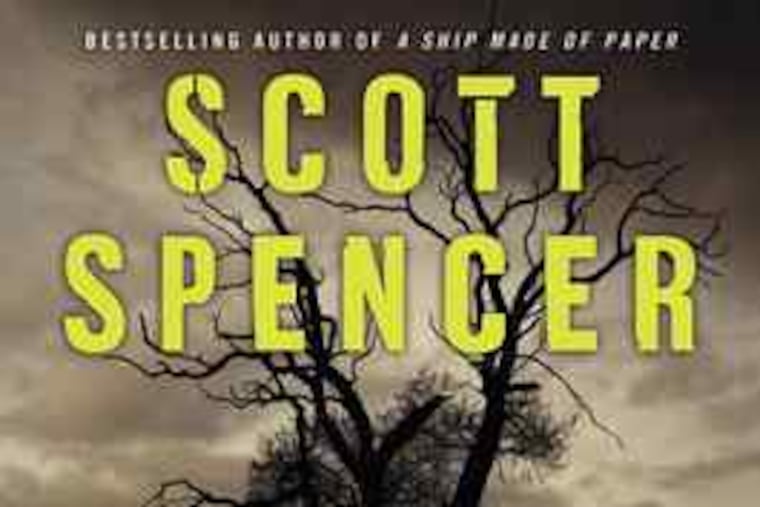A violent encounter and an internal abyss
In his 10th novel in 37 years, Scott Spencer, a two-time nominee for the National Book Award, returns to the citizens of Leyden, N.Y., the quiet upstate town that was the setting of A Ship Made of Paper (2003).

By Scott Spencer
Ecco. 305 pp. $24.99
nolead ends nolead begins
Reviewed by Kevin Grauke
In his 10th novel in 37 years, Scott Spencer, a two-time nominee for the National Book Award, returns to the citizens of Leyden, N.Y., the quiet upstate town that was the setting of
A Ship Made of Paper
(2003).
In the novel from seven years ago, Kate Ellis' lover, Daniel Emerson, a white attorney, has an affair with a married black woman, which, against the backdrop of the O.J. Simpson trial, disrupts the lives of all those connected to them.
Here, Kate Ellis' new lover, Paul Phillips, kills a stranger in a fit of anger after witnessing the man brutally beating a dog. Where A Ship Made of Paper attempted to explore the tricky intersection of race and desire, Man in the Woods aims to pursue the eternally knotty question of whether our actions - especially our most terrible actions - eventually meet with fitting and just consequences.
The novel is at its most compelling as it traces the evolution of Paul's inner turmoil. Despite trying his best to go on about his business as a high-end carpenter as if nothing has happened, he worries that he'll get caught, wonders if he should tell someone, and fears that he may be a killer at heart. And it's this last concern that seems to trouble him most: "Buried beneath all the things he used to think of as his true and essential nature . . . beneath everything familiar and everything assumed, beneath his style and beneath his ideals, beneath it all he may be a beast." Meanwhile, he bonds with the dog that he rescued, the dog that he names Shep and that becomes "the bridge which Paul walks upon as he inches his way over the abyss. . . . "
Though Paul draws the bulk of our attention, Spencer layers his novel with portraits of a number of other characters whose experiences complicate, echo, or comment upon Paul's existential condition in some fashion, all against the backdrop of 1999's Y2K millennial anxieties.
Kate, who was a journalist covering the Simpson trial in the earlier novel, is now the best-selling author of Prays Well With Others, a collection of essays that traces her "pilgrim's progress toward a sober, God-loving life." Detective Jerry Caltagirone, whose duty it is to discover the murderer of the man in the woods, steadfastly believes there's "something out there, something that says this is okay and this is not okay. . . . "
There is also Ruby, Kate's 9-year-old daughter, who claims to be able to see "birdy fairy angel[s]" and who gives Paul's sister, Annabelle, a cross to protect her not too long before Annabelle nearly dies in a car accident while delivering the mail on her postal route. And, finally, there is Bernard, Paul's brother-in-law, a Lebanese-Iranian who is being unfairly targeted by immigration officials because of a family friend.
Though most of these characters are primarily intended to be seen merely as the people who populate Paul's small world, they tend to function too blatantly as either righteous examples of goodness and justice, or victims of fate's caprice, not entirely unlike both Paul himself and the stranger whom he happened to encounter in a quiet park and then murder.
With all of these characters (and many more not named here) diffusing rather than intensifying our interest, the novel bogs down under its own weight, and it stumbles as it attempts to convince us of Paul's gradual spiritual transformation and Kate's simultaneous abandonment of her faith. Nevertheless, the precision of Spencer's eye for vibrant similes remains a pleasure throughout. A sick puppy's cough is like "a bicycle horn bleating inside a bowl of oatmeal." A groggy woman drags "sleep behind her like the hem of a muddy gown." A young girl's breath "smells of toothpaste and body heat, like candy out of the oven." An evening sky has "darkened to purple, the color of a funereal sash worn by a minister standing next to an open grave."
Alas, not even Spencer's keen sense of language and eye for telling detail are enough to hold us rapt. Initially, the novel hints at becoming an invigorating exploration of the animal within us all, as the narrator suggests in the account of Paul's attack on the man in the woods: "What is taking place is more like a realignment of inner forces, in which the voice of reason grows fainter and the voice of animal instinct becomes more and more dominant, expressing itself in a long, low, guttural roar."
Unfortunately, the story abandons this pursuit as unconvincing coincidences eventually lead us to an ending that provides a fittingly ironic resolution, but only if we are willing not to question its lack of reasonable justification.